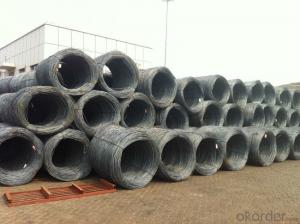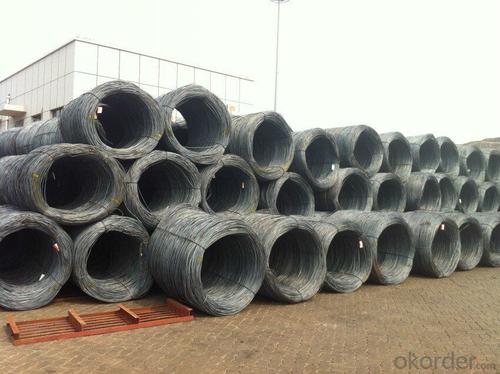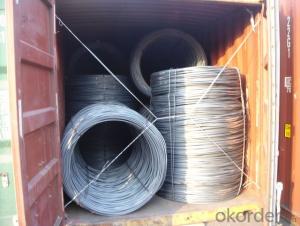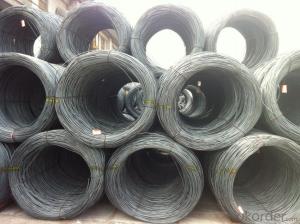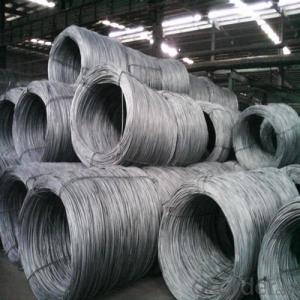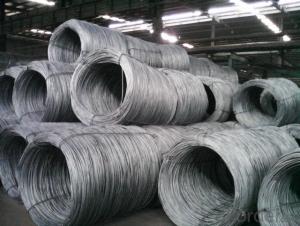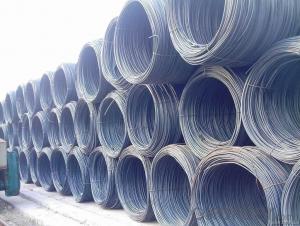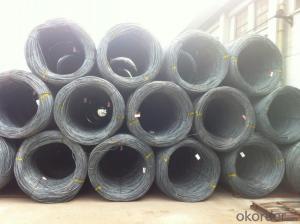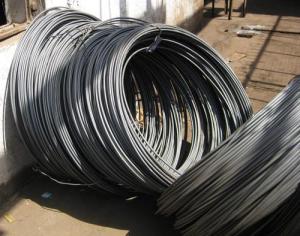New Arrival High Quality SAE1008 Steel Wire Rod
- Loading Port:
- Tianjin
- Payment Terms:
- TT OR LC
- Min Order Qty:
- 25 m.t.
- Supply Capability:
- 50000 m.t./month
OKorder Service Pledge
OKorder Financial Service
You Might Also Like
Specification
Steel Grade: Q195/235, SAE1006-1018B Standard: ASTM, GB
Diameter: 5.5mm, 6.5mm, 7mm,8mm,9mm,10mm,12mm,14mm
Type: Drawn Wire Alloy or Not: Alloy Brand Name: HSKY
Technique: Hot Rolled Place of Origin: China Mainland
Chemical Composition:(Please kindly find our chemistry of our material based on SAE1006B and SAE1008B as below for your information)
High carbon/Low carbon/common carbon Steel wire rod | With boron for rebate tax |
Grade | SAE1006B SAE1008B SAE1018B |
Package | In coil ,in bundle, |
Coil weight | about 2000kg-3000kgs |
Size: | 5.5mm 6.5mm 8mm 10mm 12mm 14mm 16mm |
Types | High Carbon ,Low carbon ,Common carbon |
Exported Country | South Korea,Vietnam,Indonesia,Myanmar,Philippines and Afrca,Ect |
Delivery term: | within 30 days after receive the LC |
Payment Term: | LC at sight ,LC 30-120 days after B/L date, TT payment |
The Standard of Physical Properties:
Grade | Chemical Composition(%) | |||||
C | Mn | Si | S | P | Cr | |
SAE1006 | 0.03~O.07 | ≤0.32 | ≤0.30 | ≤0.045 | ≤0.040 | >0.30 |
Mechanical properties | ||||||
Yield strength(N/mm2) | Tensile strength(N/mm2) | Elongation(%) | ||||
250-280 | 350-380 | ≥32 | ||||
Grade | Chemical Composition(%) | |||||
C | Mn | Si | S | P | Cr | |
SAE1008 | 0.10max | 0.3~O.50 | 0.15max | 0.050max | 0.040 max | 0.30 min |
Mechanical properties | ||||||
Yield strength(N/mm2) | Tensile strength(N/mm2) | Elongation(%) | ||||
≥195 | 315-430 | ≥30 | ||||
Usage and Applications of Steel Wire Rod in Coil:
After hot-rolled the products shaped into coil and delivery as finished product, including round, square, rectangular, hexagonal and so on, Since most of the products are round, it is generally called wire rod. Steel wire rod is widely used in construction and manufacturing. Steel wire rod is mainly used for reinforcement of reinforced concrete and welded structure or reprocessed (roberts, nail etc) materials, especially used to produce wire drawing, welding electrode, nails,spring, electronic, precise machinery parts and so on.
Packaging & Delivery of Steel Wire Rod in Coil:
Packaging Detail: products are packed in coil and then shipped by container or bulk vessel
Each coil weight: 2-3MT
Delivery Detail: within 45 days after received deposit or LC.
Label: to be specified by customer, generally, each bundle has 1-2 labels
Trade terms: CFR, CIF
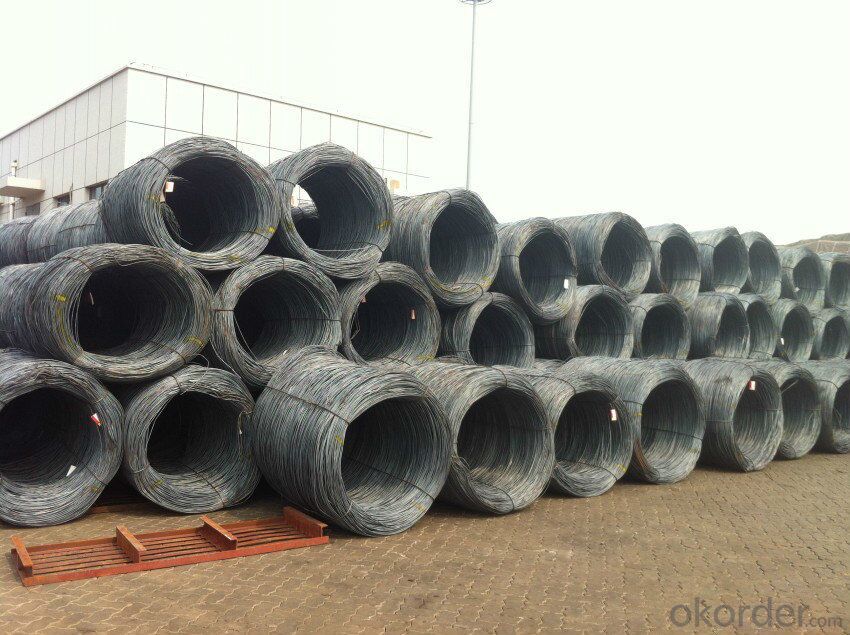
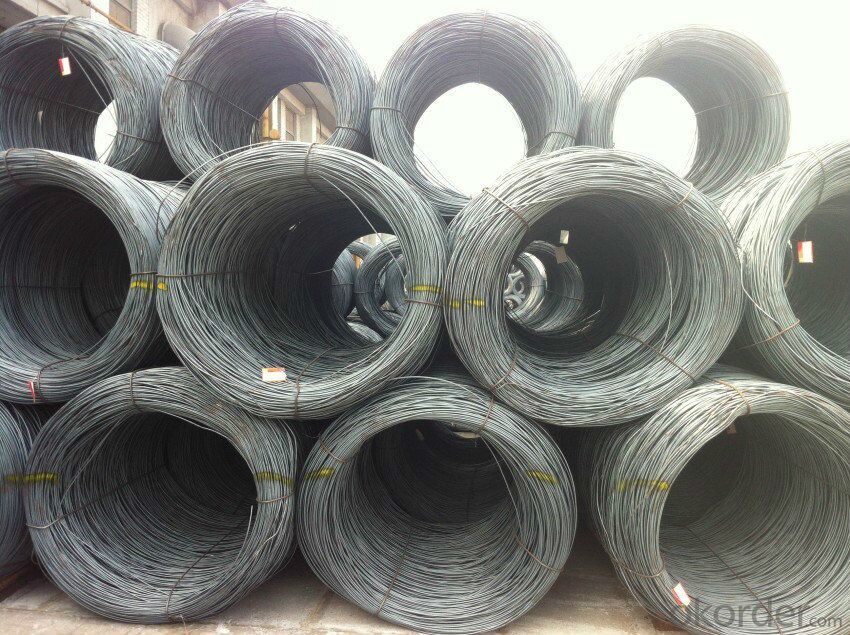
- Q: What are the different types of steel wire rod surface cleaning methods for wire drawing?
- There are several types of steel wire rod surface cleaning methods for wire drawing. These include mechanical cleaning, chemical cleaning, and electrolytic cleaning. Mechanical cleaning involves the use of brushes, abrasive pads, or shot blasting to remove dirt, rust, and scale from the surface of the wire rod. Chemical cleaning involves the use of acids or alkaline solutions to remove contaminants and oxide layers from the surface. Electrolytic cleaning uses an electric current to dissolve and remove impurities from the wire rod surface. Each method has its advantages and suitability depending on the specific requirements of the wire drawing process.
- Q: How is steel wire rod processed into different wire products?
- Steel wire rod is processed into different wire products through a series of manufacturing processes. The first step involves the uncoiling of the steel wire rod, which is typically done using a machine called a pay-off reel. Once uncoiled, the wire rod is then cleaned to remove any dirt or rust using a pickling solution or shot blasting. After cleaning, the wire rod is passed through a series of rollers to reduce its diameter and increase its length. This process is called drawing, and it is usually done in multiple stages to achieve the desired thickness and strength. The wire rod is pulled through a die in each stage, gradually reducing its diameter. Once the wire has been drawn to the desired size, it is then annealed to relieve any internal stresses and improve its ductility. Annealing involves heating the wire to a specific temperature and then slowly cooling it down. This process makes the wire more flexible and easier to work with. Next, the wire may undergo additional processes such as galvanizing or coating. Galvanization involves dipping the wire in a bath of molten zinc to provide it with a protective layer against corrosion. Coating can be done using materials such as PVC or nylon to provide the wire with additional properties, such as insulation or increased strength. Finally, the wire is spooled onto reels or packaged into coils for transportation and storage. Depending on the specific wire product being manufactured, additional processes such as cutting, bending, or welding may be performed to shape the wire into its final form. Overall, the process of transforming steel wire rod into different wire products involves a combination of drawing, cleaning, annealing, and additional treatments to achieve the desired properties and dimensions. This complex process ensures that the wire products meet the required standards and are suitable for various applications in industries such as construction, automotive, and manufacturing.
- Q: How is steel wire rod used in the manufacturing of wire for underground cable systems?
- Steel wire rod is a crucial component in the manufacturing process of wire used in underground cable systems. The steel wire rod serves as the primary raw material that is transformed into the final wire product. The production process begins with the steel wire rod being subjected to various mechanical and heat treatments to enhance its strength and durability. Once the steel wire rod has been processed, it is then drawn through a series of dies to reduce its diameter and increase its length. This drawing process helps to refine the wire's mechanical properties, such as its tensile strength and flexibility, making it suitable for underground cable applications. The drawn steel wire is then further processed to ensure it meets the specific requirements for underground cable systems. This may involve applying a protective coating, such as zinc or polymer, to enhance corrosion resistance and insulation properties. Additionally, the wire may undergo further heat treatment processes, such as annealing, to relieve internal stresses and improve its overall performance. Finally, the finished wire is wound onto spools or reels, ready to be used in the manufacturing of underground cable systems. The wire is typically combined with other components, such as insulation materials and protective layers, to form a complete cable assembly. These cables are then installed underground to facilitate the transmission of electricity, telecommunications signals, or data. Overall, steel wire rod plays a vital role in the manufacturing process of wire for underground cable systems. It provides the necessary strength, flexibility, and durability required for these cables to withstand the harsh underground environments while ensuring efficient transmission of power or information.
- Q: How is steel wire rod used in the manufacturing of wire rope connectors?
- Steel wire rod is used in the manufacturing of wire rope connectors as it serves as the raw material for producing the connectors. The steel wire rod is first drawn into the desired diameter and then undergoes a series of processes such as cutting, bending, and shaping to form the connectors. The high strength and durability of the steel wire rod make it an ideal choice for ensuring the reliability and safety of wire rope connectors in various applications.
- Q: How is steel wire rod used in the manufacturing of wire rope thimbles?
- Steel wire rod is used in the manufacturing of wire rope thimbles by being shaped, formed, and cut into the desired size and shape to create the base structure of the thimble. The steel wire rod is strong and durable, ensuring that the thimble can withstand heavy loads and provide support to the wire rope. Additionally, the steel wire rod is often galvanized or coated to enhance its corrosion resistance, ensuring the longevity and reliability of the wire rope thimble.
- Q: What are the common production processes for rutherfordium-coated steel wire rod?
- The common production processes for rutherfordium-coated steel wire rod include initial steel wire rod production, surface cleaning and preparation, application of rutherfordium coating through a chemical or physical vapor deposition process, and final quality control and packaging.
- Q: How is steel wire rod used in the manufacturing of wire for suspension bridges?
- Steel wire rod is used in the manufacturing of wire for suspension bridges as it serves as the primary raw material. The wire rod is first drawn through a series of dies to reduce its diameter and increase its strength. This process, known as wire drawing, transforms the rod into a long, thin wire with desired mechanical properties. The resulting wire is then further processed and woven into intricate cable systems, which form the main load-bearing elements of suspension bridges. The high tensile strength and durability of steel wire make it a crucial component in ensuring the structural integrity and stability of suspension bridges, allowing them to withstand heavy loads and span long distances.
- Q: What are the potential drawbacks of using steel wire rod?
- Using steel wire rod comes with several potential drawbacks. Firstly, the susceptibility of steel wire rod to corrosion and rusting when exposed to moisture or certain environmental conditions can cause material degradation over time, resulting in reduced strength and structural integrity. Secondly, the relatively heavy nature of steel wire rod compared to other materials can be a disadvantage in applications where weight is a concern. This can make transportation and handling of steel wire rod more challenging and expensive. In addition, steel wire rod may have limited flexibility compared to alternative materials. This can be a disadvantage in situations where the wire needs to be bent or shaped into complex forms or tight spaces. Furthermore, the cost of steel wire rod can be higher compared to other materials, impacting the overall cost of a project. This includes the expenses related to production, transportation, and installation, making it a less economical choice in certain cases. Lastly, steel wire rod may have limitations in terms of its electrical conductivity or magnetic properties, which can be a drawback in applications where these properties are crucial. Considering these potential drawbacks, it is important to carefully evaluate steel wire rod before selecting it for a specific application, despite its numerous advantages such as high strength and durability.
- Q: How is steel wire rod used in the production of wire mesh for oil and gas filtration?
- Steel wire rod is an essential component in the production of wire mesh for oil and gas filtration. It is used as the primary material to create the wire mesh by undergoing various manufacturing processes such as drawing, annealing, and galvanizing. The steel wire rod provides the necessary strength, durability, and corrosion resistance required for oil and gas filtration applications. It is woven or welded into a mesh structure that allows for the efficient filtration of oil and gas, removing impurities and contaminants. The wire mesh produced using steel wire rod ensures reliable and efficient filtration, making it a vital component in the oil and gas industry.
- Q: What are the safety requirements for steel wire rod used in elevator wire ropes?
- The safety requirements for steel wire rod used in elevator wire ropes are crucial to ensure the reliable and secure operation of elevators. These requirements are set by various industry standards and regulations to guarantee the strength, durability, and performance of the wire ropes. Some of the key safety requirements for steel wire rod in elevator wire ropes include: 1. Material Quality: The steel wire rod used in elevator wire ropes must meet specific material standards, typically specified by organizations such as the American Society for Testing and Materials (ASTM). These standards define the chemical composition, mechanical properties, and other characteristics of the steel to ensure it can withstand the required loads and stresses. 2. Strength: Elevator wire ropes are subject to significant loads and stresses during operation. Therefore, the steel wire rod used must have a high tensile strength to withstand these forces without breaking. The minimum tensile strength requirements are typically defined by industry standards to ensure the safety of passengers and the elevator system. 3. Fatigue Resistance: Elevator wire ropes undergo repeated bending and flexing during operation, which can cause fatigue failure if the steel wire rod is not designed to resist this. The steel wire rod should have excellent fatigue resistance properties, enabling the wire rope to withstand millions of cycles without degradation. 4. Surface Quality: The surface of the steel wire rod must be smooth and free from any defects or imperfections that could weaken the wire rope. Surface irregularities, such as pits, scratches, or deformations, can act as stress concentration points and reduce the overall strength and safety of the wire rope. 5. Dimensional Accuracy: To ensure proper fit and functionality, the steel wire rod used in elevator wire ropes must meet specific dimensional tolerances. These tolerances include diameter, roundness, and straightness, which are crucial for proper assembly and operation of the wire ropes. 6. Testing and Certification: Manufacturers of steel wire rod used in elevator wire ropes should conduct rigorous testing to verify compliance with safety requirements. These tests may include tensile strength testing, fatigue testing, surface inspection, and dimensional measurements. Certification from recognized bodies or compliance with industry standards, such as ISO 9001, further ensures the quality and safety of the steel wire rod. By adhering to these safety requirements, elevator manufacturers and operators can be confident in the reliability and performance of their wire ropes, ultimately ensuring the safety of passengers and the smooth functioning of elevator systems.
Send your message to us
New Arrival High Quality SAE1008 Steel Wire Rod
- Loading Port:
- Tianjin
- Payment Terms:
- TT OR LC
- Min Order Qty:
- 25 m.t.
- Supply Capability:
- 50000 m.t./month
OKorder Service Pledge
OKorder Financial Service
Similar products
Hot products
Hot Searches
Related keywords
